By the time students reach middle school, the focus of reading instruction shifts to reading comprehension. Do students understand what they’re reading? The purpose of this blog post is to equip you with six ideas/instructional strategies that will increase students’ reading comprehension.
Before I describe each of these strategies, I want to share the daily literacy framework I use during reading units with you. I have 70-75 minutes daily to teach reading, writing, and word study. I alternate between reading units and writing units across the school year because instruction gets way too crammed if I try to do everything every day. The daily literacy framework pictured below will be a good reference as I describe the ideas for improving students’ reading comprehension in this blog post.

Strategy One: Have a new reading learning target daily
I’ve seen many teachers take reading standards and simply use the standards as learning targets. Teachers might say, we’re focusing on reading standard 1 this week. Having a specific reading standard that you’re focusing on is great, but reading standards can be broken down even further into daily learning targets. I have actually brainstormed specific reading learning targets to align with every Common Core reading standard in this document. A portion of that document is pictured below.

I use my brainstormed list of learning targets aligned to each reading standard to make reading units that contain 20 unique reading learning targets aligned to a variety of reading standards. Each learning target represents one day of reading instruction. An example of a unit plan from my Historical Fiction Reading Unit is pictured below.
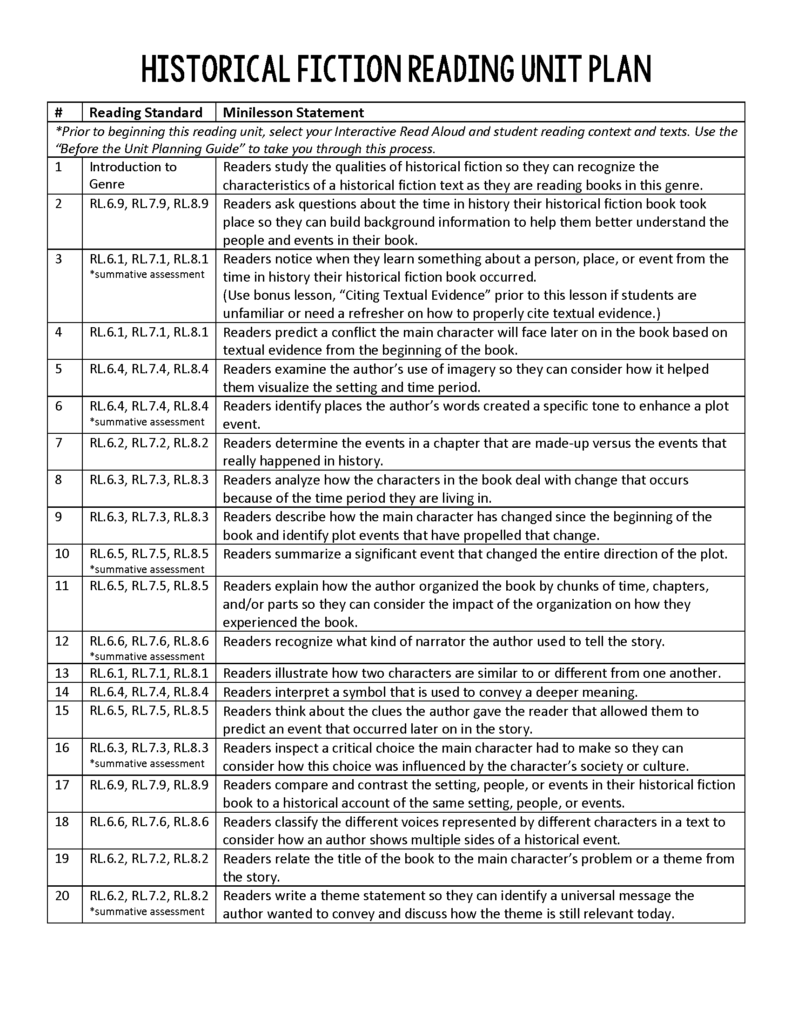
As I mentioned, every learning target represents one day of reading instruction. This helps students’ reading comprehension because the learning targets are specific and engage students daily in new learning related to reading. Below is an example of a specific learning target and how that learning target would be introduced and taught to students.
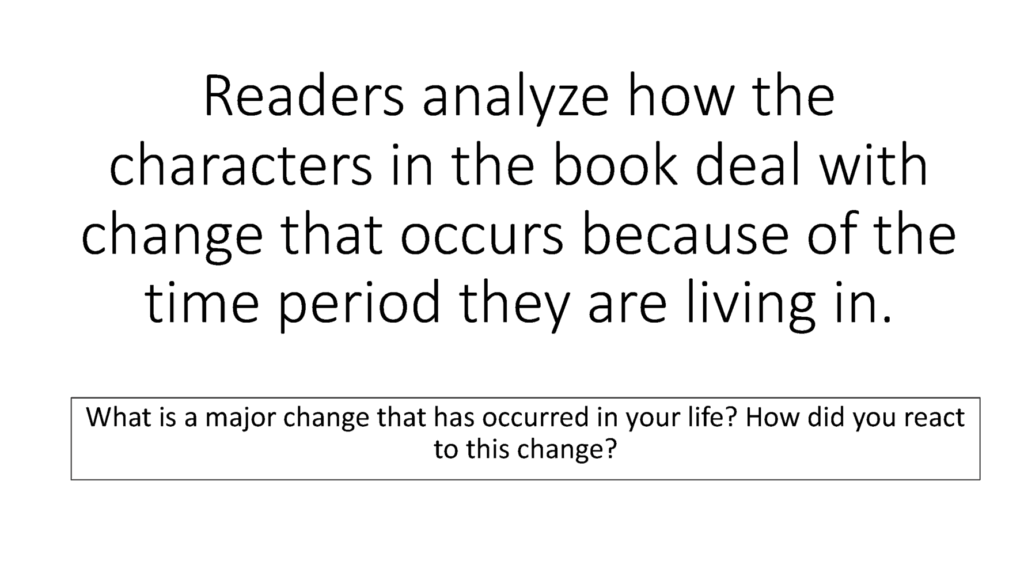
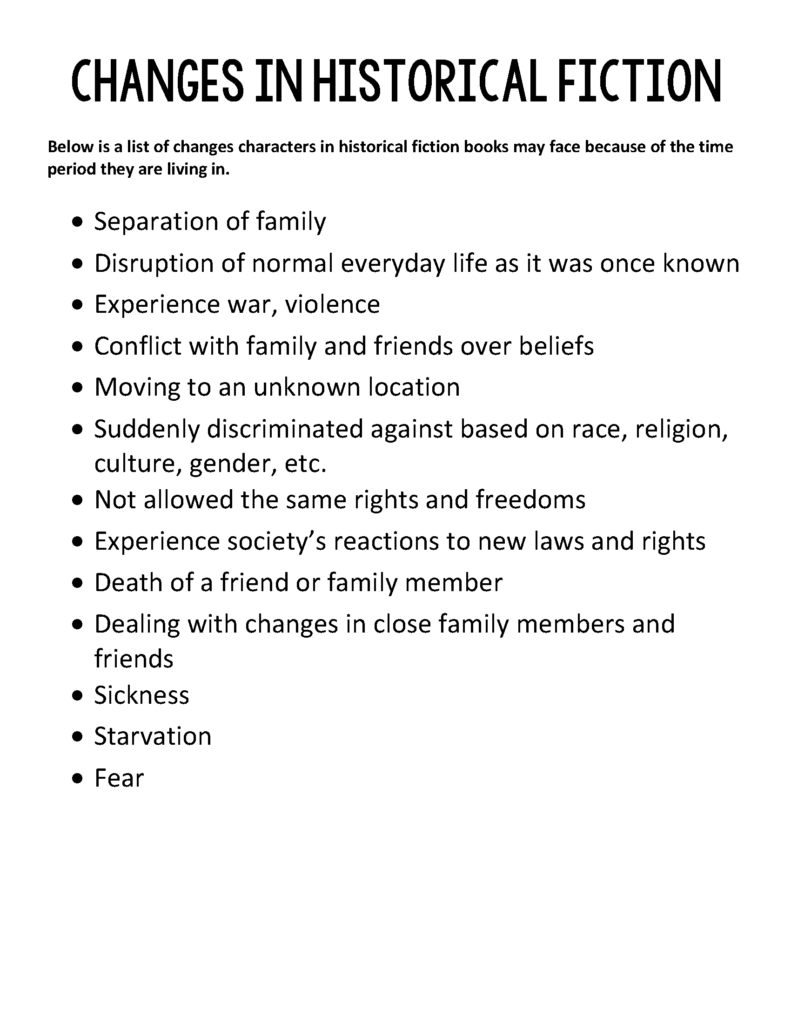

Strategy Two: Start out the class period with sticky note summaries and partner oral reading fluency practice
In this middle school I teach in, I have 75 minutes daily to teach reading, writing, and word study. I found teaching separate reading and writing lessons daily was nearly impossible, so I started alternating my instruction with a reading unit followed by a writing unit throughout the school year. During reading units, I use two different instructional practices for class starters.
The first is “sticky note summaries.” During each reading unit, students have a small group book that they are responsible for reading a portion of daily. We start out the unit by putting sticky notes into students’ books at the daily stopping points. Students write the date they are supposed to read to each page on the sticky notes. I teach students to think of the sticky note like a stop sign. When students reach their daily stopping point, they’re asked to stop and think about the 2-3 most important plot events that happened in that section of reading and jot the summary down in chronological order like the sticky note pictured below.

At the beginning of the class period, students get with a partner who is reading the same book as them and share their sticky note summary from the previous day’s reading. Students are also encouraged to discuss this portion of the book. This works best when students are seated next to someone reading the same book as them. Once students get this routine down, I give about 2 minutes for students to share their summaries for the day. The presentation slide I have up to guide this activity looks like this.
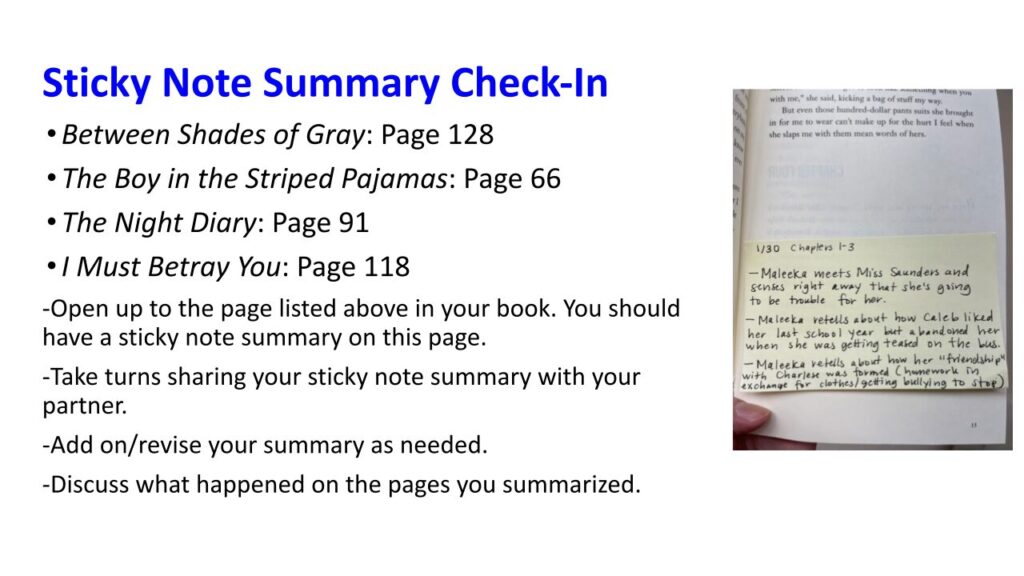
This boosts reading comprehension because students are encouraged to stop and reflect on what the most important events from the reading were daily and write it down. This is then reinforced by students talking about it daily with a peer reading the same book as them. This is great for all students, but especially great for students who do the reading but struggle to remember what they read.
Partner oral reading fluency comes next. Because students have daily page goals, I pick a page from each of the small group books that was part of the previous day’s reading. This is then a reread for students. How it works is students pair up with a partner (who is preferably reading the same book as them) and pick a Partner A and a Partner B. I set my timer for 1 minute and prompt all students who are “Partner A” to begin reading. I call “stop” when the minute is up and prompt “Partner B” to get ready to read. Partner B reads the same page listed on the board, and I do the same prompting for starting and stopping 1 minute of reading. The slide I use to guide this activity is shown below.
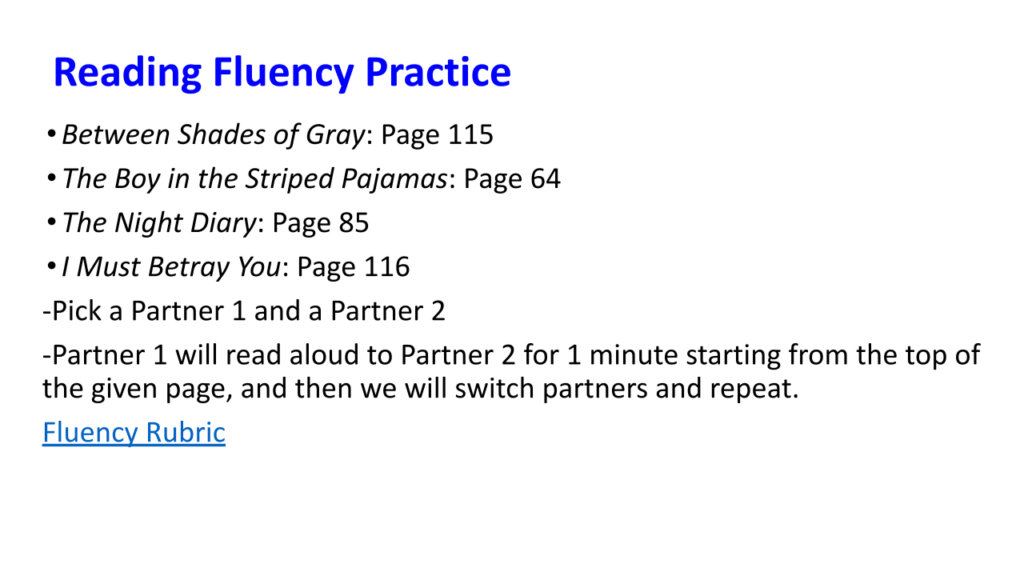
I find this aids in reading comprehension because it is a rereading from the day before. This helps students review events. It also helps students’ reading fluency to read aloud every day. Reading fluency is directly correlated with reading comprehension, but it is often a forgotten practice in middle school classrooms.
Strategy Three: Plan lessons using the gradual release of responsibility
Using the gradual release of responsibility while teaching is a great teaching practice in ANY content area. It works great in aiding reading comprehension because it actually equips teachers to show how to think while reading. Below is a snapshot of what the gradual release of responsibility could look like in a reading lesson.

Now, I’ll show you what a teacher lesson plan for a specific reading learning target could look like using the gradual release of responsibility.

Finally, I’ll show you what this could look like as a presentation to students.
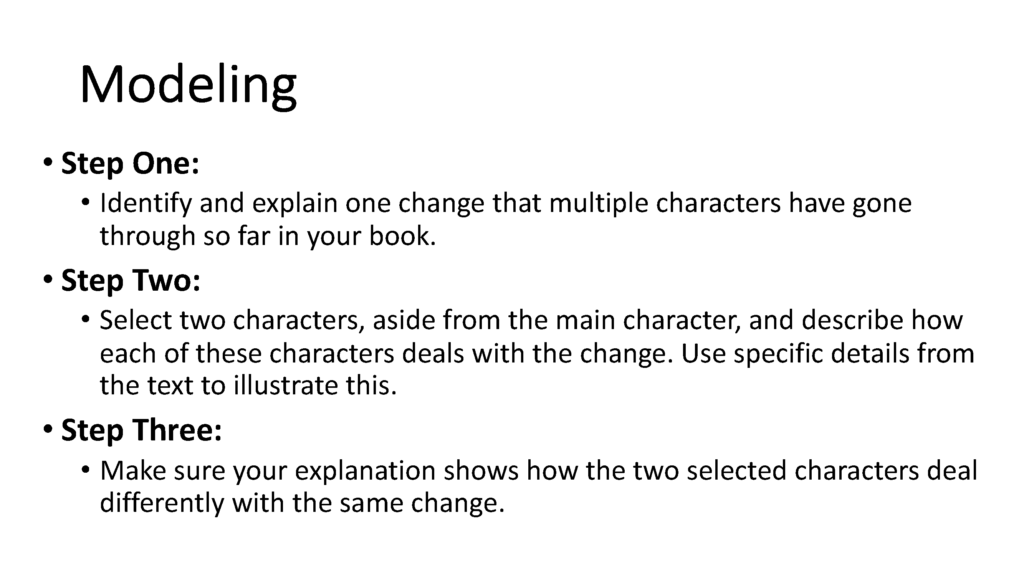
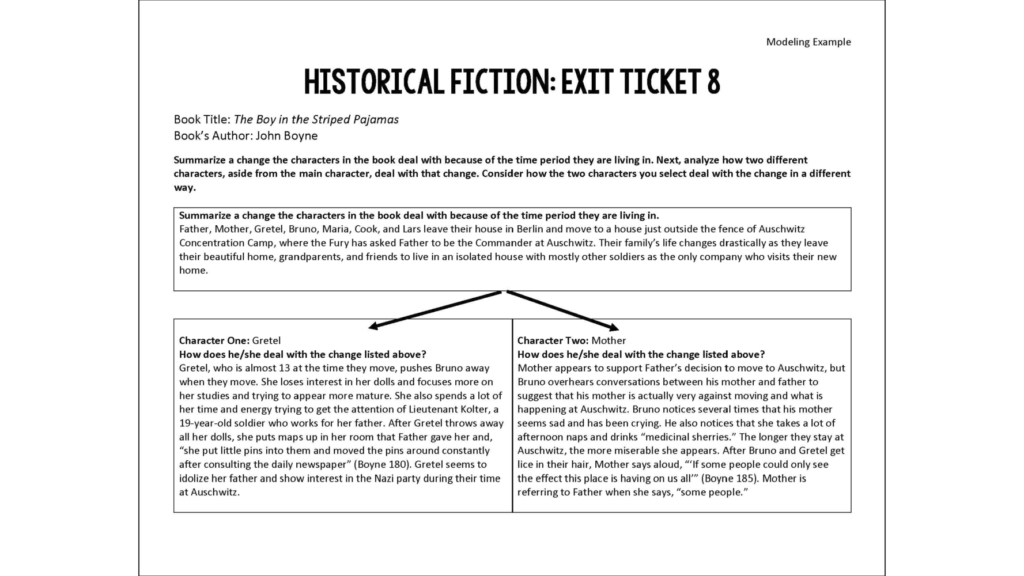
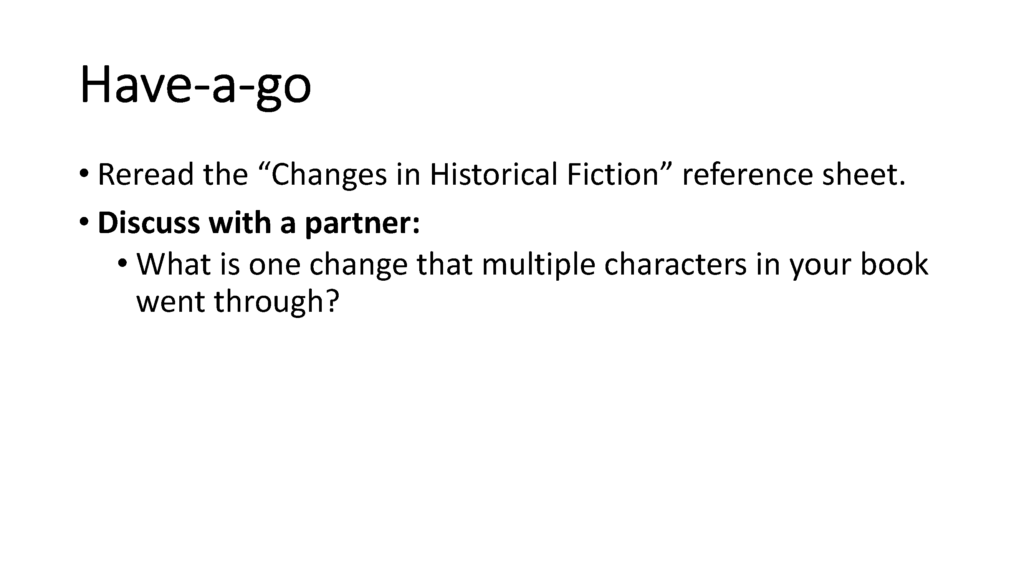
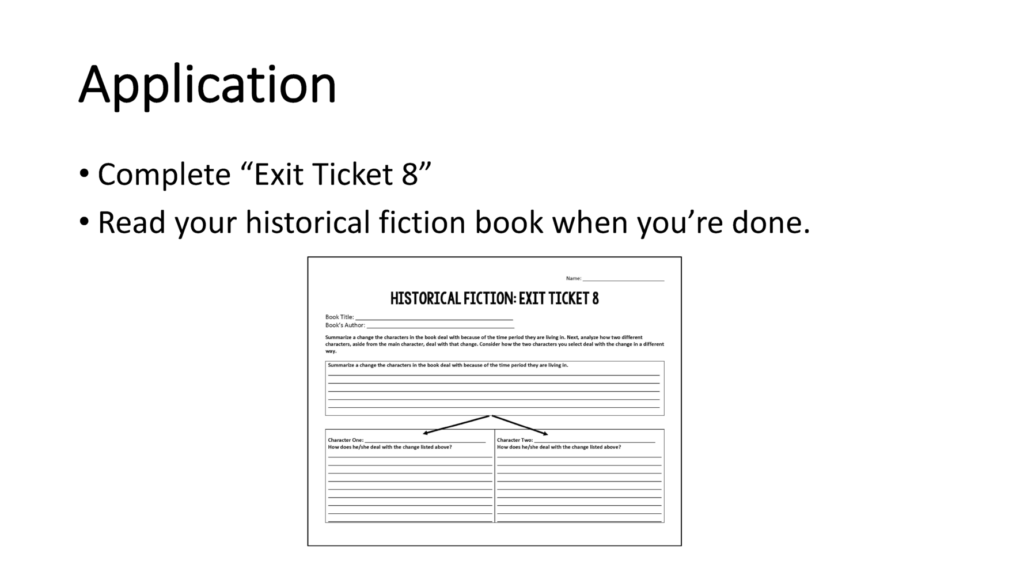
Strategy Four: Use the Interactive Read Aloud-Small Group Book Format
Each reading unit I do is focused toward a specific genre. Here are the reading units by genre I have available:
–Myth & Fairy Tale-Inspired Fiction
In this blog post, I’ve been using my Historical Fiction Reading Unit to show these different ideas. During my Historical Fiction Reading Unit, I read aloud a historical fiction book to students. I read a full book from start to finish and plan out how much of the interactive read aloud book I will read to students each day so that I finish the book by the end of the unit. Teachers often ask how I have time to fit in an interactive read aloud. Two tricks I’ve used throughout the years to fit IRA’s in are starting the IRA during a writing unit to give us a head start with the book (and keep the read aloud routine going throughout the school year) and using novels in verse within the genre of the reading unit. Novels in verse are quick and engaging. They make perfect read alouds. Below you will see the Historical Fiction Reading Unit Plan with the interactive read aloud, Out of the Dust, mapped out across the unit.
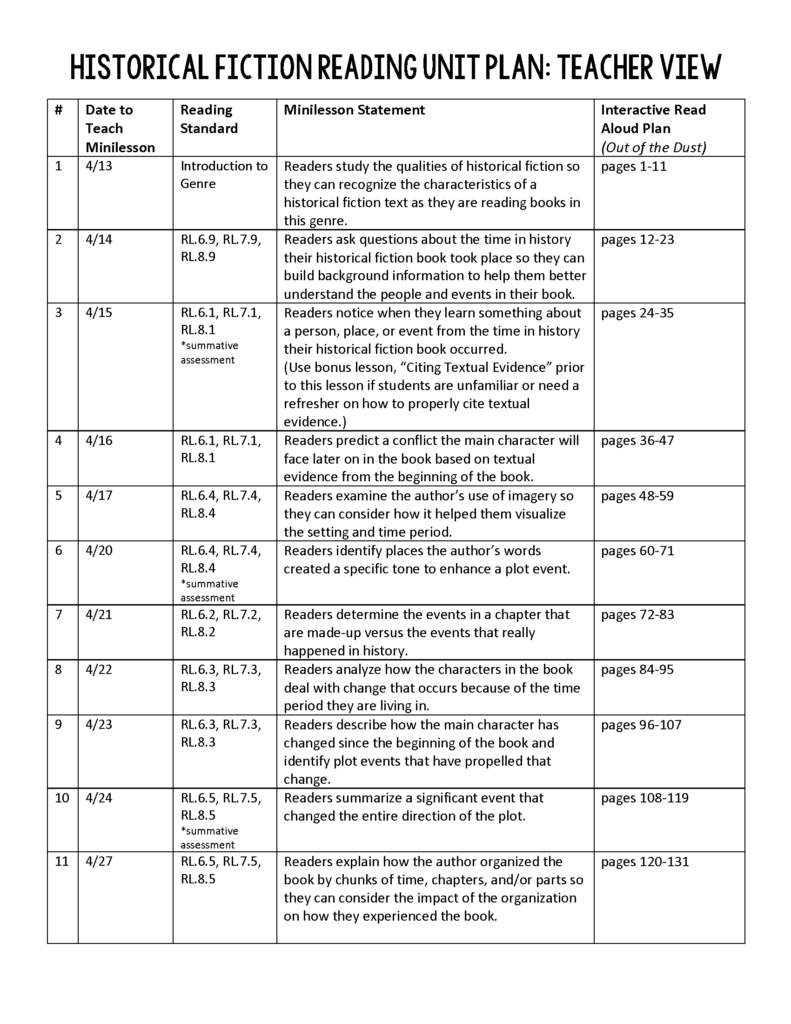
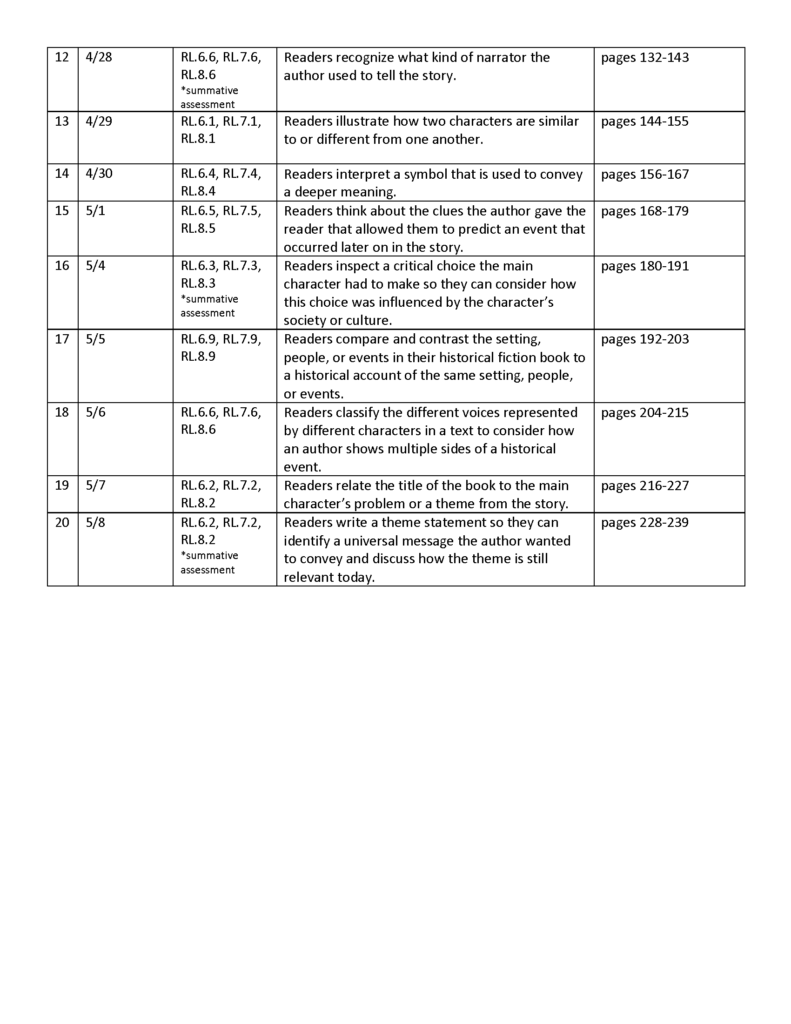
Using an interactive read aloud allows the teacher to have a text to model the daily learning target from without “giving away” the answers for the daily application in relation to the learning target. Students are given independent reading options from a text set within the historical fiction genre at the beginning of the unit and apply the reading learning target application to their book.
Interactive Read Aloud also allows the teacher to model the reading learning target being presented to students that day in real time with a common text all students have reference to. Another great thing about interactive read aloud is you will find out you have some middle school students who have amazing listening comprehension, but their reading comprehension falters when they have to read a book independently. This could be due to word recognition or even being able to attend to an independent text. Either way, this student is very different from a student who struggles with reading comprehension with read aloud and independent reading books alike.
Below is an example of how teachers can connect the reading learning target to instruction during interactive read aloud with intentional stopping points and before/after the text questions.

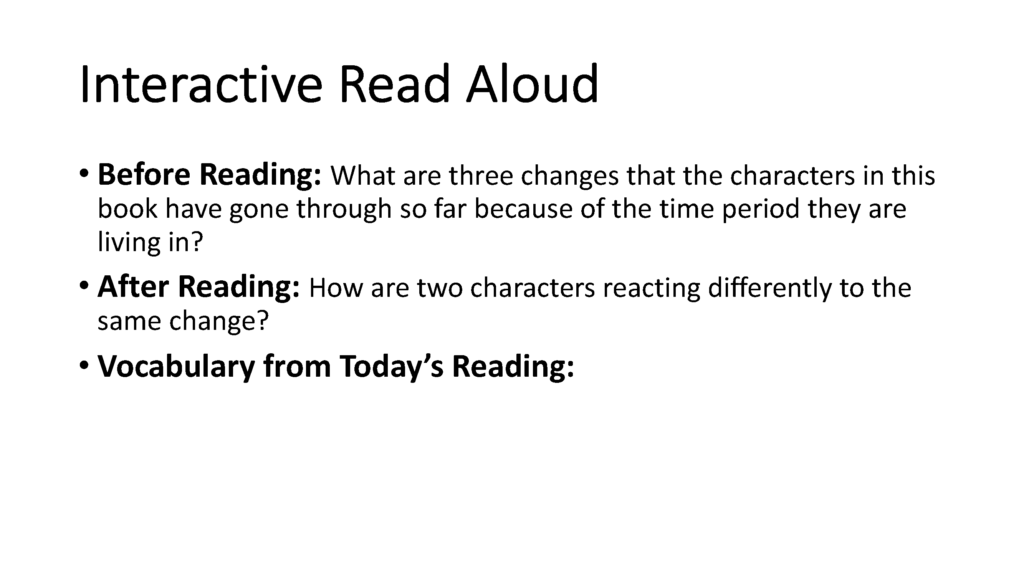
Strategy Five: Prepare reading prompts for small group reading instruction/reading conferences specific to the lesson.
Another strategy for improving reading comprehension for middle school students is to align the question prompts you ask with the daily learning target. These question prompts would be asked during the “application” portion of the reading lesson when all students are independently reading and/or working on an Exit Ticket. This is when I normally pull individual students for reading conferences or small groups of students for literature circles, guided reading, or book clubs.
Below is an example of how I match my question prompts for reading conferences or small reading groups with the daily reading lesson. There is nothing better than getting to have conversations with students about reading to gauge their reading comprehension.

Strategy Six: Focus exit tickets/reading response/assessments on reading skills versus book details
We have all heard the analogy that if you give a person a fish, they have one meal to eat, but if you teach a person how to fish, that person will be able to feed themselves for life. This same analogy can be applied to teaching reading. As ELA teachers, we’re passionate about books, and we can easily fall into the trap of teaching students about a specific book over teaching students reading skills and strategies they can apply to every book they read.
If we are using a whole class novel format and all of our lessons revolve around the book instead of reading strategies, we’ll end up with students who understand the plot of one book. We need students to walk away from weeks of reading instruction with more than the understanding of the plot and characters of one book. Reading instruction is more than asking comprehension questions about the plot of a single book.
Below is an example of an Exit Ticket that focuses on reading strategies and skills that can be applied to any book. The proficiency rubric also shows that you’re assessing complex thinking in relation to reading.
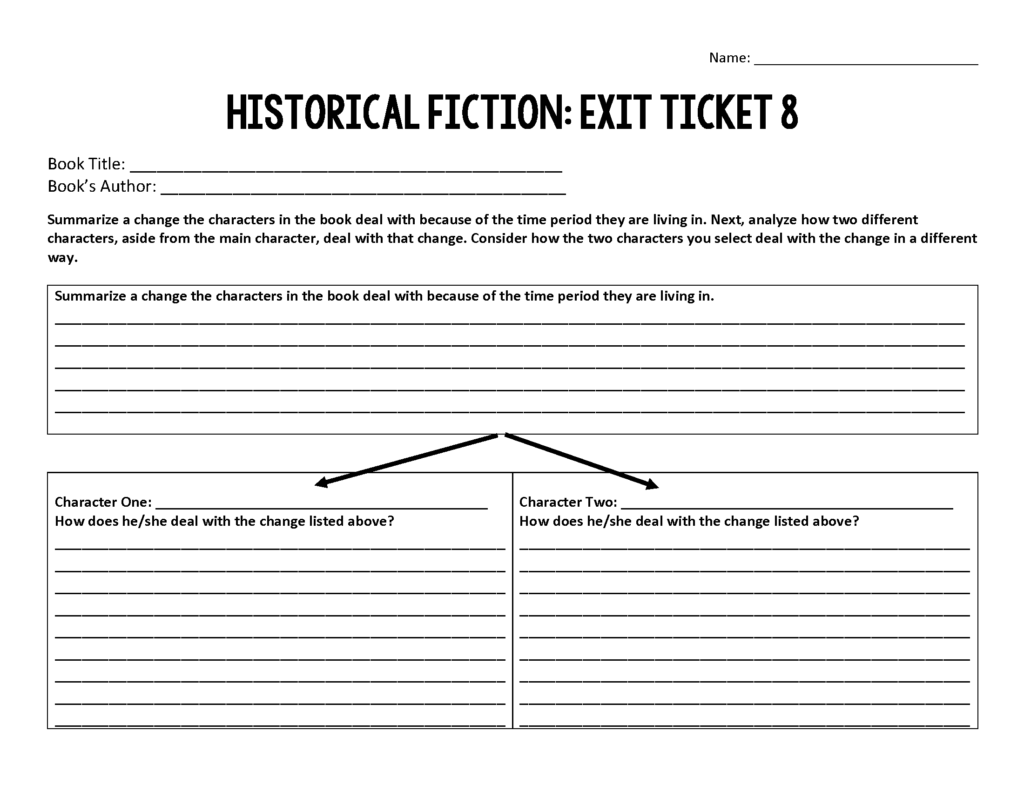
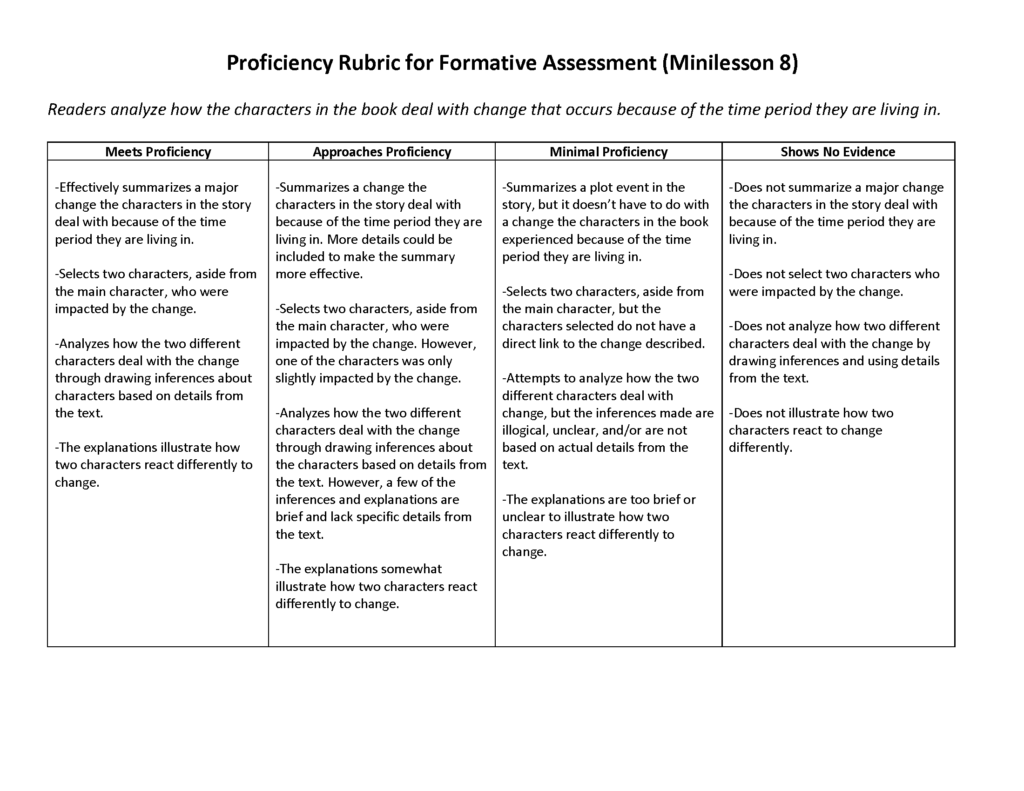
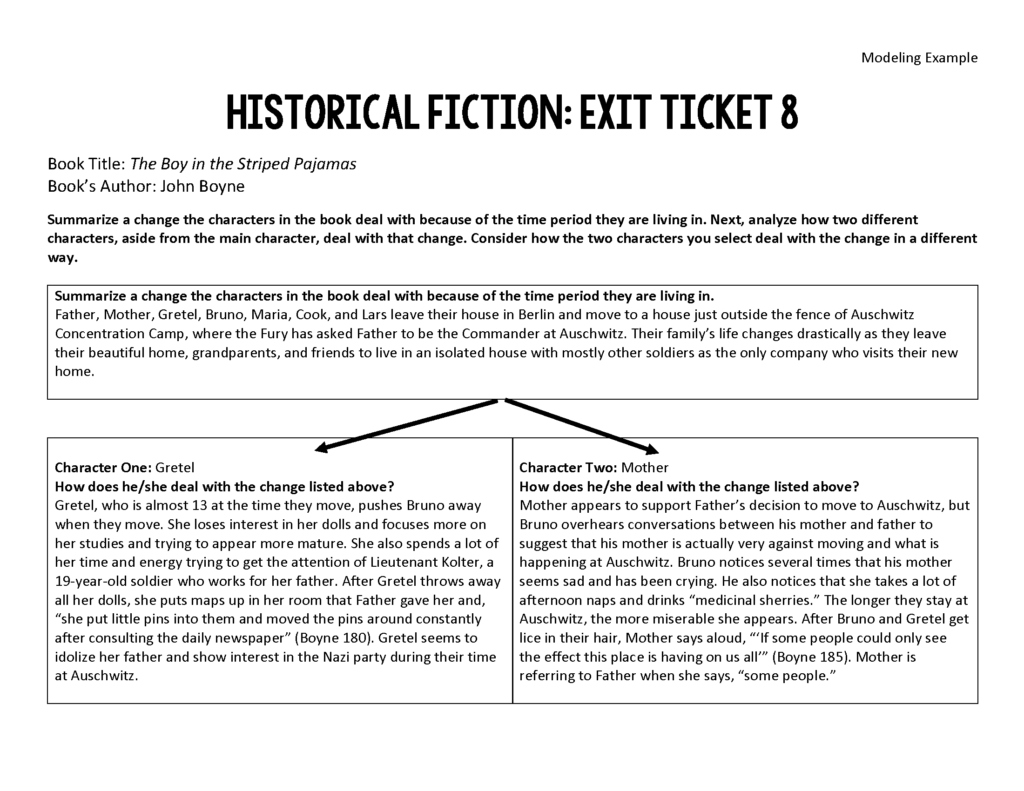
Final Thoughts
Reading comprehension is the ultimate goal when we’re teaching reading to our middle school students. If all foundational pieces of learning to read have been put in place at the elementary level, then we want to ensure students understand what they read at a deep level.
If you love the ideas in this blog post, but aren’t sure where to start with preparing curriculum materials to align with these goals, consider looking into my middle school reading units. Every idea mentioned in this blog post is already prepped and ready to go for you. There are seven reading units total with 20 unique reading lessons included with each unit. Here is the link to the year-long reading curriculum, which is a bundle of the 7 reading units.





